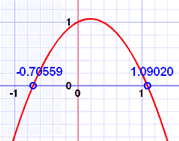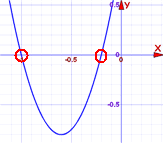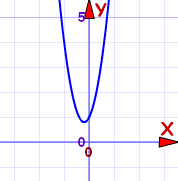Quadratic Equations
Name
The name Quadratic comes from "quad" meaning square, because the variable gets squared (like x2).
It is also called an "Equation of Degree 2" (because of the "2" on the x)
It is also called an "Equation of Degree 2" (because of the "2" on the x)
Standard Form
The Standard Form of a Quadratic Equation looks like this:
|
| 2x2 + 5x + 3 = 0 | In this one a=2, b=5 and c=3 | |
| x2 − 3x = 0 |
This one is a little more tricky:
|
|
| 5x − 3 = 0 | Oops! This one is not a quadratic equation: it is missing x2 (in other words a=0, which means it can't be quadratic) |
Hidden Quadratic Equations!
So the "Standard Form" of a Quadratic Equation is
But sometimes a quadratic equation doesn't look like that! For example:
ax2 + bx + c = 0
| In disguise | → | In Standard Form | a, b and c |
|---|---|---|---|
| x2 = 3x -1 | Move all terms to left hand side | x2 - 3x + 1 = 0 | a=1, b=-3, c=1 |
| 2(w2 - 2w) = 5 | Expand (undo the brackets), and move 5 to left |
2w2 - 4w - 5 = 0 | a=2, b=-4, c=-5 |
| z(z-1) = 3 | Expand, and move 3 to left | z2 - z - 3 = 0 | a=1, b=-1, c=-3 |
| 5 + 1/x - 1/x2 = 0 | Multiply by x2 |
5x2 + x - 1 = 0 | a=5, b=1, c=-1 |
 |
Have a Play With ItPlay with the "Quadratic Equation Explorer" so you can see:
|
How To Solve It?
The "solutions" to the Quadratic Equation are where it is equal to zero.
There are usually 2 solutions (as shown in the graph above).
They are also called "roots", or sometimes "zeros"
There are 3 ways to find the solutions:There are usually 2 solutions (as shown in the graph above).
They are also called "roots", or sometimes "zeros"
1. We can Factor the Quadratic (find what to multiply to make the Quadratic Equation)
2.
We can Complete the Square, or
3. We can use the special Quadratic Formula:

.

Just plug in the values of a, b and c, and do the calculations.
We will look at this method in more detail now.Discriminant
Do you see b2 - 4ac in the formula above? It is called the Discriminant, because it can "discriminate" between the possible
types of answer:
Complex solutions? Let's talk about them after we see how to use the formula.
Example: Solve 5x² + 6x + 1 = 0
| Coefficients are: | a = 5, b = 6, c = 1 | |
| Quadratic Formula: | x = [ −b ± √(b2 − 4ac) ] / 2a | |
| Put in a, b and c: | x = [ −6 ± √(62 − 4×5×1) ] / (2×5) | |
| Solve: | x = [ −6 ± √(36−20) ]/10 | |
| x = [ −6 ± √(16) ]/10 | ||
| x = ( −6 ± 4 )/10 | ||
| x = −0.2 or −1 |
 |
Answer: x = -0.2 or x = -1
And we see them on this graph. |
| Check -0.2: | 5×(-0.2)² + 6×(-0.2) + 1 = 5×(0.04) + 6×(-0.2) + 1 = 0.2 -1.2 + 1 = 0 |
| Check -1: | 5×(-1)² + 6×(-1) + 1 = 5×(1) + 6×(-1) + 1 = 5 - 6 + 1 = 0 |
Complex Solutions?
When the Discriminant (the value b2 - 4ac) is negative we get Complex solutions ... what does that mean?It means our answer will include Imaginary Numbers. Wow!
Example: Solve 5x² + 2x + 1 = 0
| Coefficients are: | a = 5, b = 2, c = 1 | |
| Note that The Discriminant is negative: | b2 - 4ac = 22 - 4×5×1 = -16 | |
| Use the Quadratic Formula: | x = [ -2 ± √(-16) ] / 10 | |
| The square root of -16 is 4i (i is √-1, read Imaginary Numbers to find out more) |
||
| So: | x = ( -2 ± 4i )/10 | |
 |
Answer: x = -0.2 ± 0.4i
The graph does not cross the x-axis. That is why we ended up with complex numbers. |
No comments:
Post a Comment